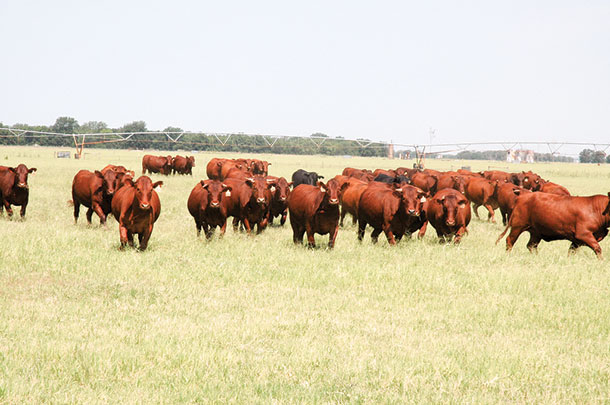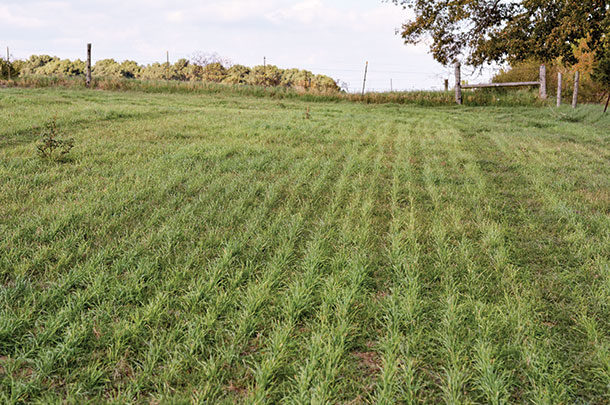These grasses are highly productive from the months of May through October in most areas of the state but leave roughly six months of the year without a forage source for grazing cattle unless pastures are stockpiled or cattle are supplemented with hay.
Sod-seeding (also called overseeding) annual cool-season grasses such as wheat, rye or ryegrass is one way to reduce hay costs and generate high-quality feed for cattle over the winter months in Texas. This also allows producers the opportunity to utilize their land, rainfall and nutrients more efficiently.
Small grains and ryegrass forage are generally higher in protein and digestibility than feeding hay or stockpiled forage and are also cheaper than feeding hay. However, there are certain risks associated with establishing small grains or ryegrass in sod. Because of the amount of residue often left on the soil surface, seed is often planted into a “less-than-ideal” seedbed.
It may be difficult to achieve good seed-to-soil contact, which makes establishment difficult. Regardless of the cultural practices used, establishment of cool-season grasses is very weather-dependent and low fall moisture can lead to poor forage growth, delayed planting or crop failure.
Selecting the proper species for your pasture is the first and perhaps most critical decision to be made to ensure a proper stand, good forage growth and overall fit for your grazing system. Small-grains species used for overseeding include wheat, rye, oats, barley and triticale.
Though not a small-grains species, ryegrass is also a very common choice for sod-seeding. Factors such as temperature, soil texture, soil pH and rainfall play an important role in species adaptability to a certain region.
Choosing the right species
Rye is well adapted to acidic soils and cold temperatures and is a good choice for northern parts of Texas. It is also the earliest maturing small-grains species and thus does not interfere with spring growth of bermudagrass.
Rye performs very well in lighter soils and drier regions of the state compared to other small grains, but growth is more limited in wet soils.
 Triticale shares many of the same traits as rye and is another excellent choice for drier regions of the state.
Triticale shares many of the same traits as rye and is another excellent choice for drier regions of the state.
Ryegrass will produce abundant spring forage and is a great choice for areas with high rainfall or heavy soils. Producers do need to be aware that ryegrass is considerably later-maturing than all the other cool-season annual grasses.
Thus, fall forage production is generally quite low, and the stand must be terminated early enough so as to not interfere with bermudagrass growth in late spring. Otherwise, ryegrass can greatly reduce bermudagrass stands.
Oats provide a slightly earlier maturing alternative to ryegrass in higher rainfall zones. They often provide excellent fall and spring growth; however, they are the most cold-sensitive of the cool-season grasses, and their range is often limited to central and southern portions of the state.
They will routinely freeze out in the High Plains and occasionally winterkill in the Rolling Plains and northeast Texas. Also, diseases such as crown and stem rust can be problematic in oats in more humid climates.
Barley is less cold-sensitive than oats but more sensitive than wheat or triticale. While winterkill is unlikely anywhere in the state, leaf burn occurs more readily from cold temperatures than other small grains and can thus impact winter grazing.
Still, barley varieties produce good fall growth and are competitive with other small grains in total forage production.
Wheat is perhaps the most versatile of all the small grains and is the most commonly grazed cool-season annual grass across the state, mainly due to its status as a major commodity. It matures earlier than oats and ryegrass and later than rye, and provides moderate to good forage production, depending on the variety.
It is moderately tolerant of acidic and alkaline soils, and grows under a wide range of environments and soils.
Preparing to plant
In order to successfully establish cool-season grasses in a perennial warm-season pasture system, producers need to remove most of the aboveground residue. This can be done through heavy grazing, haying or shredding.
Stubble height should be reduced to less than 2 inches, which allows for easier planting, better seed-to-soil contact and more sunlight to newly developing seedlings.
No-till drills on a narrow row spacing (less than 7.5 inches) are the preferred choice for cutting through the remaining residue and getting seed into the soil at a uniform depth. If broadcasting seed, a light disking (down 2 or 3 inches) is advantageous to improve seed-to-soil contact. Disking any deeper will disturb bermudagrass roots and harm stands.
A pre-plant application of a non-selective herbicide can be used to assist dieback of bermudagrass and reduce weed pressure. Keep in mind, the herbicide needs to be a contact herbicide (paraquat or diquat) and not a systemic product, such as glyphosate, which will translocate to the roots and reduce bermudagrass stands.
Reducing fertilizer rates for bermudagrass in late summer can also reduce growth in the fall as it enters into dormancy.
Fertility
As with any forage or grain crop, adequate fertility is needed to maximize forage yield in cool-season annual grasses. For every 1,000 pounds of forage removed, roughly 30 to 40 pounds nitrogen (N), 7 to 10 pounds diphosphorus pentoxide (P2O5) and 30 to 35 pounds potassium oxide (K2O) is removed.
Knowing your yield goal is important to estimating the amount of fertilizer needed. Another important practice is soil sampling. Crediting nutrients already in your soil can reduce over-application of nutrients and cost.
Total phosphorus and potassium requirements can be applied in the fall because of their immobility in the soil; however, N is generally used most efficiently when split-applied.
So if you are expecting 6,000 pounds of forage throughout the season but only 2,000 pounds in the fall, then you might want to apply 80 pounds N soon after establishment and another 160 pounds N in late winter before spring greenup.
If mild winter temperatures lead to more winter growth, perhaps apply earlier. With ryegrass, an additional application may be needed in late spring.
Other agronomics
In general, cool-season annual grasses can be planted six to eight weeks before the first killing frost, but it is dependent upon when bermudagrass enters into dormancy and will no longer compete with young seedlings. When using a drill, planting rates often range from 120 to 150 pounds per acre for wheat and rye, while barley, triticale and oats range from 80 to 120 pounds per acre.
Ryegrass is considerably smaller-seeded and thus rates are much less: 20 to 40 pounds per acre. If broadcasting seed, these rates should be increased by 25 percent to account for poorer germination.
Grazing should begin only after sufficient crown root development has occurred to fully anchor plants to the soil. This generally equates to 6 inches of top growth or two months after planting. In the spring, all small grains or ryegrass should be terminated by May in order to reduce competition with bermudagrass. ![]()
PHOTO 1: Rows of planted small-grain rye emerge in a bermudagrass field at the Texas A&M Overton Center’s South Farm. Producers have difficulties properly timing fertilizer applications during above-average temperatures and dry conditions. Texas A&M AgriLife Extension Service photo by Adam Russell.
PHOTO 2: Cattle graze bermudagrass pastures in Texas. Pasture yield can be boosted by overseeding cool-season grasses for winter grazing. Texas A&M AgriLife Extension Service photo by Blair Fannin.
Clark Neely, Ph.D., is a small-grains and oilseed extension specialist with the A&M AgriLife Extension Service. Email Clark Neely.










